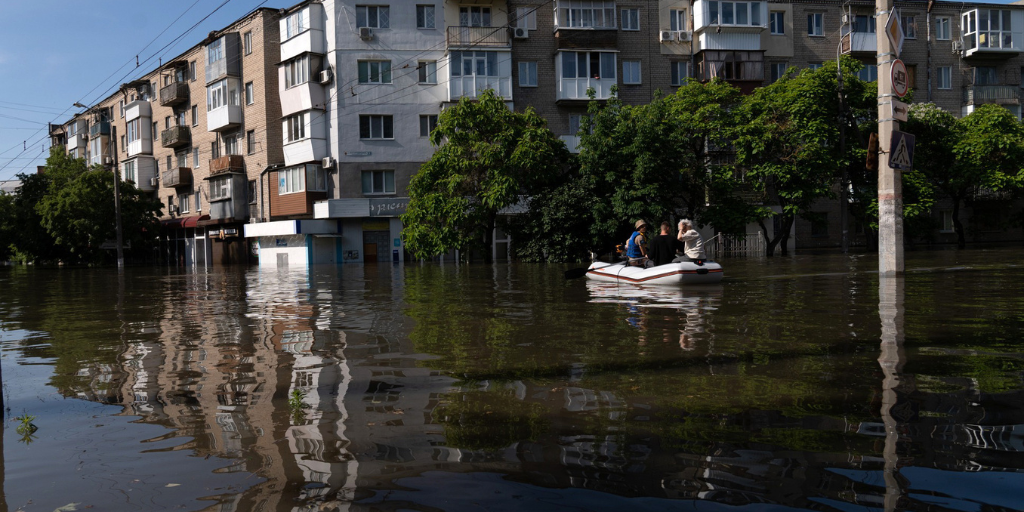On 6 June 2023, Russian occupiers blew up the biggest dam in Ukraine. The destruction of the Kakhovka hydropower plant threatens huge environmental and humanitarian consequences for the south of Ukraine and the entire Black Sea region.
Vladlena Martsynkevych, Project Leader, Ukraine Reconstruction | 15 June 2023

Kherson after the destruction of Kakhovka Hydroelectric Power Plant, Source: Dsns.gov.ua
Bankwatch condemns the destruction of Ukraine’s Kakhovka dam and the massive damage it is causing to human lives and the environment. In response to this criminal act, we join Ukraine’s civil society in calling on international experts, institutions that aim to protect the environment, secretariats of international environmental conventions and authorised bodies to respond to this latest act of ecocide.
Irreparable environmental damage
The explosion caused immediate downstream flooding, which heavily impacts people in southern Ukraine. Due to the scale of the disaster, there will be inevitable impacts on the water supply for millions of people and sizeable amounts of agricultural land during the coming summer months and beyond.
Major environmental threats include severe damage to ecosystems in six Emerald sites protected by the Bern Convention and the pollution of the Dnipro river’s waters with toxic chemicals, garbage, animal corpses and erosion. The dam’s destruction has also impeded the water intake necessary for cooling the Zaporizhia nuclear power plant. Greenpeace CEE has warned of the associated threat to nuclear safety.
The machinery of the Kakhovka hydropower station is in ruins, with its dam damaged. Consequently, there is uncontrolled water outflow from the Kakhovsky reservoir. We anticipate temporary impacts resulting from the flooding of the islands and territories below. However, an even greater impact will arise from the water shortage, as the Kakhovsky reservoir is the primary water source for southern Ukraine’s irrigation system. We can expect significant problems for agriculture and the local population, who rely on it for their livelihoods.
The Zaporizhska nuclear power plant will not be immediately affected since it has its own cooling reservoir, separated from the Kakhovsky reservoir by a dam. This reservoir will have sufficient water supply for several weeks. As the reactors at the power plant are believed to be shut down, the demand for water is low. However, the lack of water increases the risk of potential complications, which could lead to a nuclear fuel meltdown. The Ukrainian energy sector is already facing a challenging summer period due to the need for maintenance and delayed routine repairs after a harsh winter.
Russia must pay
Together with representatives of the environmental civil society movement in Ukraine and internationally, we call on the international community (United Nations and all state parties to the International Criminal Court) to provide assistance to Ukraine in gathering evidence, assessing all the consequences of such a crime on the environment, and taking quick measures to reduce and mitigate the consequences for the people and nature of southern Ukraine. The international environmental community (United Nations Environment Programme, Global Environment Facility, etc.) and funders should also act immediately and develop mechanisms to prevent such environmental destruction in the future. An open discussion on the feasibility of restoring the blown-up facilities must be held with the public in Ukraine, bearing in mind the already enormous projected cost of EUR 800 million and five-year timeline for restoration.
More preliminary conclusions, expected environmental consequences and key recommendations from Ukrainian civil society and authorities can be found in the following materials:
- Destruction of the Kakhovka HPP: preliminary conclusions and possible consequences – Environment People Law (epl.org.ua)
- Destruction of Kakhovka hydro dam: reaction from Ukrainian campaigners insist US, EU and G7 strengthen and enforce full embargo on Russian fossil fuels | Razom We Stand
- Committee news – Statement of the Committee on Environmental Policy and Nature Management on the act of terrorism – undermining of the Kakhovka HPP by the occupiers and causing irreparable damage to the environment – Official portal of the Verkhovna Rada of Ukraine
- Destruction of Ukraine’s biggest dam impacts the environment (ifaw.org)
- EEB Statement Concerning the Destruction of the Kakhovka Dam in Ukraine
- Greenpeace warns of environmental damage from Kakhovka Dam destruction | Greenpeace
Never miss an update
We expose the risks of international public finance and bring critical updates from the ground – straight to your inbox.
Institution: EU
Theme: Reconstruction of Ukraine
Location: Ukraine
